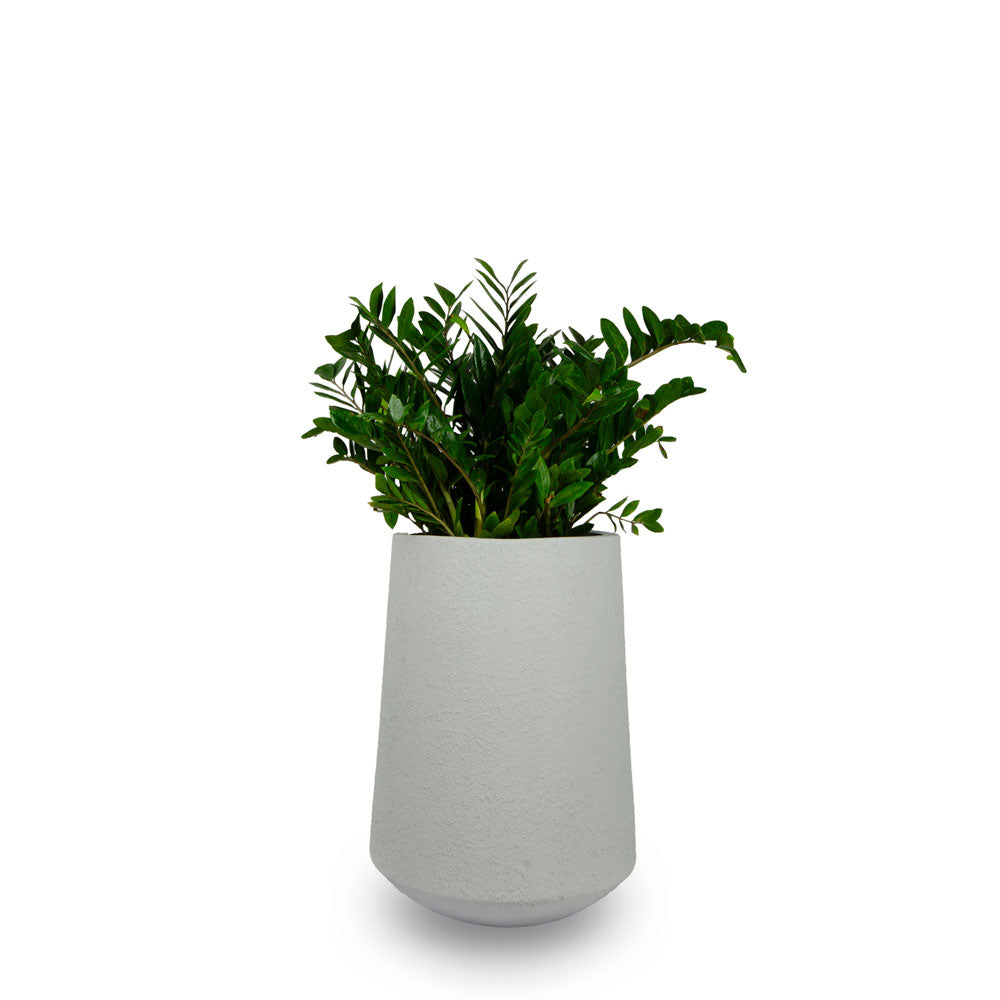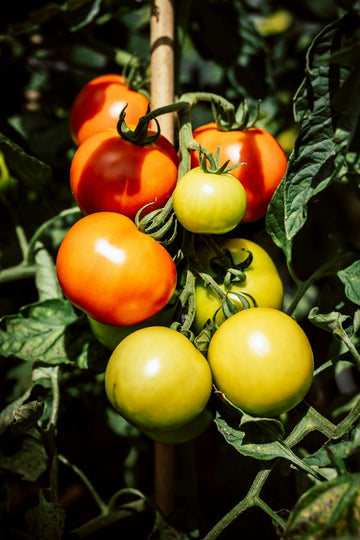Fiddle leaf figs are some of the most popular houseplants around, and it's easy to see why. They are tropical plants with large, lush, violin-shaped leaves that make a bold statement in any room.
One of the most unique characteristics of fiddle leaf figs is their size. They can grow up to six feet tall indoors, so they're perfect for filling empty spaces and making a big impact. They also have a naturally upright habit, which makes them a great choice for those who want a plant that's easy to care for and looks great all year round.
Fiddle leaf figs can be a bit finicky when it comes to their care, and getting the right balance of light, water, and temperature is crucial for their success. Let's dive into these key factors and provide you with some tips and tricks for keeping your fiddle leaf fig healthy and happy.
Factors to Keep Your Fiddle Fig Leaf Healthy
Choosing the Right Environment | Light | Temperature | Humidity
Watering and Fertilizing | Soil Type | Watering Frequency | Fertilizer Type
Pruning and Shaping | When to Prune | How to Prune | Shaping Techniques
Common Problems and Solutions | Brown spots & yellowing leaves | Bleached Leaves | Leaf drop | Pests
Propagation | Stem cuttings | Air layering | Planter Recommendations
Choosing the Right Environment
Click on the image to buy
Light
Fiddle leaf figs love bright, indirect light. In their natural habitat, they grow under the canopy of other trees and receive dappled sunlight. Indoors, they should be placed near a bright window that receives a lot of natural light but not direct sunlight. Direct sunlight can scorch their leaves, causing brown spots or even killing the plant. The same lighting approaches are used for plants like Bamboo Palm, Areca Palm, and ZZ plant to avoid any leaf burn,
If your fiddle leaf fig isn't receiving enough light, it will show signs of distress. The leaves may start to droop or turn yellow, or the plant may stop growing altogether. On the other hand, if it's receiving too much light, the leaves may become crispy and brown around the edges.
To maintain the right amount of light, consider rotating your fiddle leaf fig every few months. This will ensure that all sides of the plant receive equal amounts of light and will help prevent it from leaning toward the window. You can also use sheer curtains or blinds to filter the light if necessary.
(back to top)
Temperature
Fiddle-leaf figs are tropical plants, so they prefer warm temperatures. They don't do well in drafty areas or near air conditioning vents, which can cause their leaves to dry out and drop.
(back to top)
Humidity
Fiddle leaf figs also love humidity, and they thrive in environments with high moisture levels. In dry climates or during the winter months, the air in your home may become too dry, which can cause your fiddle leaf fig's leaves to turn brown and brittle.
To combat this, you can mist your plant regularly with a spray bottle, or place a tray of water near the plant, which will create a small microclimate of humidity around the plant.
(back to top)
Watering and Fertilizing
Click on the image to buy
Soil Type
Fiddle leaf figs prefer well-draining soil that is rich in nutrients. A high-quality potting mix can provide the drainage and aeration that your plant needs to thrive. Avoid using heavy or clay soil, as this can cause water to accumulate around the roots and lead to root rot.
To ensure your fiddle leaf fig has the best soil possible, consider repotting it every year or two. This will allow you to refresh the soil and provide your plant with fresh nutrients. When repotting, choose a planter that is only a few inches larger than the current planter, as fiddle leaf figs prefer to be slightly root-bound.
(back to top)
Watering Frequency
Fiddle leaf figs need regular watering, but they don't like to sit in water. Overwatering can lead to root rot, while underwatering can cause the leaves to droop and fall off.
In general, it's best to water your fiddle leaf fig once a week, allowing the soil to dry out slightly between waterings. You can test the soil by sticking your finger into the top inch of soil – if it feels dry, it's time to water. Be sure to use room-temperature water, as cold water can shock the roots.
(back to top)
Fertilizer Type and Frequency
Fiddle leaf figs require regular fertilization to maintain their lush foliage and promote growth. A balanced fertilizer can provide your plant with the nutrients it needs. Liquid fertilizers are a good choice, as they can be easily absorbed by the roots.
During the early summers, fertilize your fiddle leaf fig every two to four weeks. During the winter season, you can fertilize less frequently, about once a month. Always follow the label’s instructions for the correct dosage and application method.
(back to top)
Pruning and Shaping
When to Prune
The best time to prune your fiddle leaf fig is during the growing season, which is early summer. This is when the plant is actively growing and can handle the stress of pruning. However, if you notice any dead or damaged leaves or stems, you should prune them off as soon as possible, regardless of the season.
(back to top)
How to Prune
To prune your fiddle leaf fig, you'll need a pair of clean, sharp pruning shears. Begin by examining the plant and identifying any dead, damaged, or yellowing leaves or stems. Use the pruning shears to make a clean cut as close to the stem as possible. For larger branches or stems, make the cut at a 45-degree angle to promote healing.
When pruning your fiddle leaf fig, it's important to avoid removing too many leaves or stems at once. This can cause the plant to go into shock and can slow down its growth. Instead, focus on removing any dead or damaged leaves or stems, as well as any branches that are growing in a direction that you don't want.
(back to top)
Shaping Techniques
Fiddle leaf figs can be shaped in a variety of ways, depending on your preferences and the plant's growth habits. One popular technique is to prune the top of the plant to encourage bushier growth.
Click on the image to buy
This can be done by making a horizontal cut at the desired height, just above a node or leaf. This will encourage new growth from the sides of the plant.
Another shaping technique is to prune the sides of the plant to create a more compact shape. This can be done by removing any branches that are growing out too far or crossing over other branches. By pruning these branches, you can create a more balanced and symmetrical shape.
It's important to note that fiddle leaf figs are slow-growing plants, so shaping can take some time. Be patient and don't over-prune, as this can cause the plant to become stressed and slow down its growth.
(back to top)
Common Problems and Solutions
These plants are mostly safe from common plant diseases, but they can be prone to leaf damage and small pests. Here’s what you can do to protect your plant:
-
Brown spots & yellowing leaves: Brown spots or yellowing leaves can be caused by a number of factors, including overwatering, underwatering, low humidity, or exposure to direct sunlight. Make sure to water your fiddle leaf fig properly (letting the soil dry out slightly between waterings), avoid placing it in direct sunlight, and maintain a consistent level of humidity.
-
Bleached Leaves: Bleached or burned leaves are another common problem that fiddle leaf fig owners may encounter. This can happen when the plant is exposed to too much direct sunlight, which can cause the leaves to become bleached and discolored. To prevent bleached leaves, make sure to place your fiddle leaf fig in a bright, but indirect light. Ideally, it should receive bright, filtered light for several hours a day, but it should be shielded from direct sunlight. If your fiddle leaf fig is already experiencing bleached leaves, you may want to consider moving it to a shadier spot or using sheer curtains to filter the light.
-
Leaf drop: Leaf drop is a common problem with fiddle leaf figs, and it can be caused by changes in temperature, low humidity, overwatering, or underwatering. Try to keep your fiddle leaf fig in a consistent environment, away from drafts or heating/cooling vents. Make sure you're watering it properly and maintaining the right level of humidity.
-
Pests: Like all plants, fiddle leaf figs can be susceptible to pests such as spider mites, mealybugs, and scale insects. If you notice signs of infestation, such as webbing or tiny white insects, try wiping the leaves down with a solution of water and neem oil. You can also use a neem oil spray to help control the pests.
(back to top)
Propagation
It's fairly easier to grow new fiddle leaf figs from plant cuttings, rather than starting from scratch with seeds. Here are a few techniques you could use:
-
Stem cuttings: This method involves taking a cutting from a healthy fiddle leaf fig plant and encouraging it to develop roots. To do this, select a healthy stem with at least one node (the spot where the leaves attach to the stem). Cut the stem at a 45-degree angle just below the node and plant it in a container filled with room-temperature water. Place the container in a warm room with bright, indirect light. Change the water only when it gets cloudy. Within a few weeks, you'll notice small white bumps appearing on the base of the stem that's dipped in water. In a couple of weeks after that, roots will start growing from these spots in the water. Once the roots have reached a length of 1 to 2 inches, transfer the cutting into a planter filled with potting soil. Make sure the soil is damp and keep it moist but avoid overwatering.
-
Air layering: This method involves creating a small wound on the stem of a fiddle leaf fig plant and encouraging it to develop roots in that spot. To do this, select a healthy stem and make a small cut about 1/3 of the way through the stem. Wrap it with a damp paper towel or peat moss. Moisten the moss or towel and cover it with plastic wrap and secure it with twine or tape. After a few weeks, you should see new roots forming at the cut site. Once the roots are well-established, you can cut the stem below the new growth and pot it in well-draining soil in a planter.
With proper care and attention, your fiddle leaf figs can thrive and make a beautiful addition to your home. Simply listen to your plant to ensure that your plant stays healthy and happy for years to come!
(back to top)
Recommendation for your Fiddle Fig Plant
Discover more planters for your Fiddle Fig Plant













 At Palasa, we believe in the seamless fusion of nature, design and humanity.
At Palasa, we believe in the seamless fusion of nature, design and humanity.